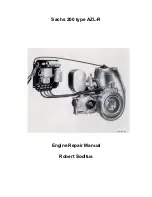
4.1.3. Fuel
Only refuel when engine is stopped.
Never refuel close to open flames or
flammable sparks, don’t smoke. Use only pure
fuel and clean replenishing vessels. Don’t spill
the fuel.
14
Pos.
1
= Fuel feed line
Pos.
2
= Fuel return line
All diesel fuels sold as fuel and complying with
the following minimum specification can be
used:
EN 590
or
BS 2869 A1 / A2
or
ASTM D 975 - 1D / 2D
Low temperature resistance
At low temperatures, the viscosity of Diesel fuel
increases. This may result in clogging of the fuel
system. Thus, winter fuel must be used at out-
side temperatures below 0 °C, or petroleum
must be added in time.
Bleeding the injection system
Air may enter into the injection system if the fuel
tank is completely emptied or while the primary
fuel filter or the fuel filter are replaced.
To bleed the system, proceed as described be-
low, depending on whether the fuel tank is
arranged in
HIGH
position above the fuel supply
pump, or in
LOW
position below the fuel supply
pump:
Fuel tank HIGH
– Fill fuel tank completely with diesel fuel.
– Start the engine as described in Chapter 4.2.
Note:
The fuel system is bled automatically when the
engine is started. To this effect, starting may
take longer than usual.
To save the starter and the battery, do not
actuate the starter continuously for more than
15 to 20 seconds at a time. Make pauses of
approx. 1 minute between the various starting
attempts. Should the engine fail to start even at
the 2
nd
attempt, locate and eliminate the trouble
(Chapter 6).
Lowest ambient
temperature when
starting, in °C
Paraffin content for:
Summer
fuel
Winter
fuel
0 up to –10
–10 up to –15
–15 up to –20
–20 up to –30
20 %
30 %
50 %
–
–
–
20 %
50 %
17
















































